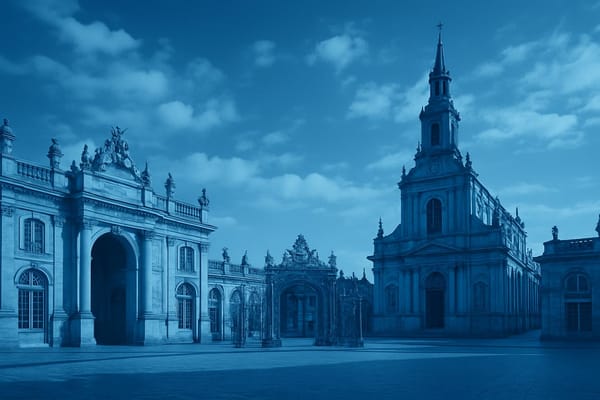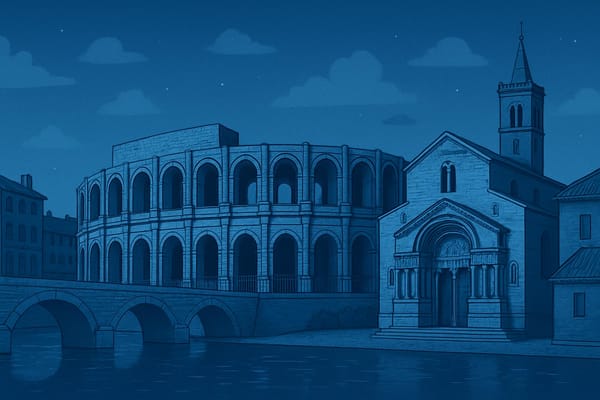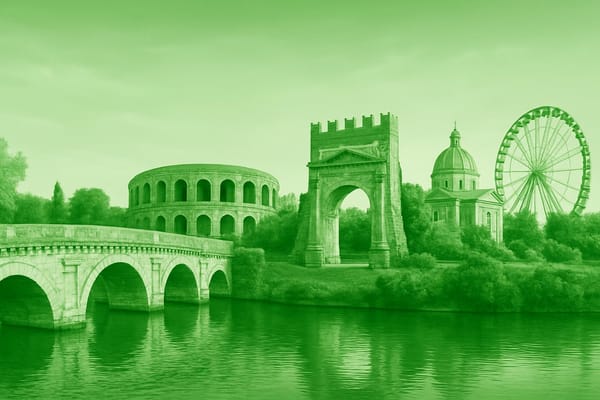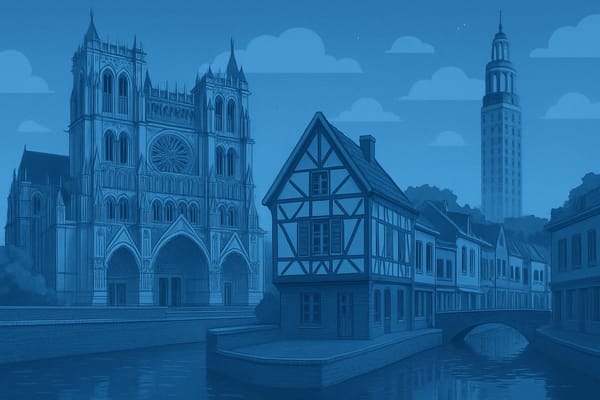Rostock
Discover a Hanseatic harbor, brick-Gothic charm, Baltic beaches & lively maritime festivals.
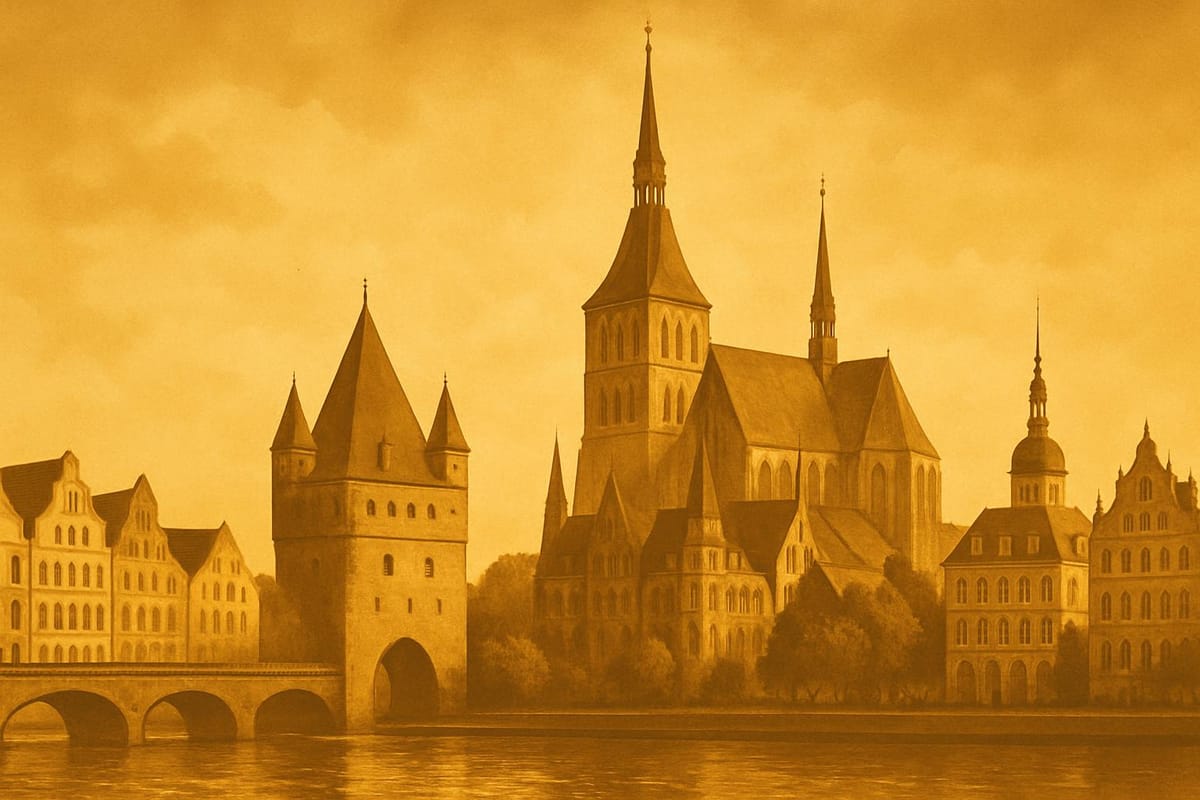
Important things to know about Rostock
Rostock sits comfortably on the southwestern shore of the Baltic Sea, a Hanseatic port where red-brick Gothic facades meet wide maritime horizons. Visitors will immediately notice the city’s layered history: the medieval skyline marked by the soaring spire of Marienkirche (St. Mary’s Church), the Renaissance flourishes of the old Town Hall, and the lively pedestrian artery of Kröpeliner Straße lined with cafés and independent shops. Having walked those cobbled lanes at dawn, I can attest to the subtle soundtrack of church bells, distant horn calls from the harbor and the scent of smoked fish drifting from market stalls - sensory details that give Rostock its distinct seaside character. One can easily combine cultural exploration with coastal relaxation; a short S-Bahn or regional train ride brings you to Warnemünde, the city’s sandy seaside quarter, where a stroll along the beach promenade and a view of the lightship at the Neuer Strom perfectly complement museum visits and urban sightseeing.
Practical knowledge matters when planning a trip, and the city rewards curious travelers with well-documented attractions and local expertise. The University of Rostock, founded in 1419, anchors the city’s academic life and contributes to a lively calendar of lectures, galleries and student-run events that enliven the historic center. Maritime heritage is on full display at the harbor museums and during the annual Hanse Sail, a sailing festival that draws tall ships and enthusiasts from across Europe each August. Looking for authentic local flavors? Try smoked herring or a plate of fresh Baltic fish at a harbor-side restaurant and pair it with regional beer; these culinary choices reflect centuries of coastal trade. Public transport is straightforward, and English is commonly spoken in tourist areas, but knowing a few friendly phrases in German always improves interactions and shows respect for local culture.
Why choose Rostock over other northern German destinations? Because it balances a compact, walkable old town with genuine access to the sea and living traditions rather than a staged tourist veneer. For travelers who value maritime history, architecture, and easy day trips along the Mecklenburg coast, Rostock is a practical, satisfying base. If you prefer to avoid crowds, visit outside the peak summer weekend of Hanse Sail and enjoy quieter streets and calmer beaches. The city’s museums, university collections and preserved urban fabric offer verifiable, expert-level insights into Hanseatic trade and coastal life, and local guides, information centers and official timetables provide reliable, trustworthy support for planning. In short, Rostock rewards both leisurely exploration and informed curiosity - who wouldn’t want a day of Baltic breeze, historic charm and well-earned seafood to round out the itinerary?
Sightseeing hot-spots in Rostock
Rostock sits where history meets the Baltic Sea, a Hanseatic port with a layered personality that rewards curious travelers. From my own walks along the cobbled streets and waterfront quays, the city reveals itself slowly: a medieval core of red brick, a lively harbor still echoing with maritime trade, and a seaside district where gulls wheel above sunlit sand. Visitors seeking sightseeing and local culture will find Rostock both compact and richly textured - museums and monuments are close enough to combine in a single day, yet each quarter has its own atmosphere. One can feel the weight of centuries in the façades of the old university buildings and the everyday pulse of a modern port city in the ferry whistles and fish markets.
The historic center is where many tourist hotspots gather. Strolling down Kröpeliner Straße, you pass shops and cafes before arriving at the Neuer Markt, where the ornate Town Hall faces the famous St. Mary’s Church (Marienkirche) with its astronomical clock and soaring tower. The brick Gothic architecture of the Hanseatic era tells a story of trade and civic pride, and the University of Rostock - one of the oldest in northern Europe - imparts a scholarly calm that blends with student energy. If you enjoy details, look up: carved stone, stepped gables and the subtle patina on bronze statues. These are not merely photo opportunities; they are living heritage. I recommend pausing in a café to watch locals and visitors pass, absorbing the cadence of language and the scent of fresh coffee and baked goods.
A short tram or bike ride leads to the harbor and the seaside resort of Warnemünde, a seaside promenade famous for broad beaches, a historic lighthouse, and a working commercial pier where ferries depart for the Baltic routes. Here the tone changes: there is space, salt air and an unmistakable seaside economy - fish stalls selling hot Fischbrötchen, sailing boats bobbing in the marina and families promenading at dusk. For those interested in maritime history, Rostock’s Museum of Shipping and Harbor exhibits and harbor cruises provide context and vivid storytelling about shipbuilding and seafaring life. Want to experience the city from the water? A short boat trip offers perspectives you can’t get from land, revealing industrial docks, cranes and the long sweep of coastline that frames this port.
Practical advice matters when planning a visit: peak season runs from late spring to early autumn, when ferry traffic and beach crowds increase; shoulder months offer quieter streets and often milder prices. One can navigate Rostock easily on foot, by tram or bike - public transport is reliable and the city center is largely pedestrian-friendly - but check current opening hours for museums and guided tours, especially around public holidays. For responsible travel, choose locally run tours, support independent cafes and respect conservation measures along the coastline. As someone who has returned to Rostock repeatedly, I can attest that its blend of historic landmarks, maritime character and approachable local culture makes it a rewarding destination for both first-time visitors and seasoned travelers alike.
Hotels to enjoy in Rostock
Rostock sits where the Warnow river meets the Baltic, a Hanseatic port city with a compact Old Town, a working harbor and a seaside suburb at Warnemünde. For visitors seeking comfort and convenience, hotels in Rostock span boutique guesthouses tucked into medieval lanes, mid-range city-center hotels for business travelers, and larger seaside resorts that catch the morning light. Speaking from multiple visits to the region, I can say the atmosphere shifts charmingly depending on where one stays: the cobblestones and Gothic gables of the Altstadt feel intimate and historic, while the harbor district hums with maritime energy and ferries loading at dawn.
Neighborhood choice often dictates experience. In the city center and along Kröpeliner Straße one finds practical, well-located Rostock hotels - think reliable chains and business-class properties - handy for exploring museums, the university and the main train station. Closer to the water, accommodations range from family-run pensions to upscale resorts with spa facilities and sea-view terraces in Warnemünde. Examples of popular options include international and local brands such as the Steigenberger Hotel Sonne, IntercityHotel and the long-standing beachfront classics near the promenade, though one can also discover cozy bed-and-breakfasts and aparthotels for longer stays. Prices vary seasonally; budget travelers often secure rooms around €60–€90 in low season, while mid-range stays typically run €90–€160 and luxury or coastal suites can exceed €200 per night during summer and cruise periods.
Practical tips improve any stay: book early for summer weekends and cruise arrivals, check whether breakfast and parking are included, and ask about room orientation if a river or sea view matters to you. Many properties are well-connected by tram and regional trains, making day trips to nearby Mecklenburg villages and beach towns straightforward. Expect standard German hotel amenities - reliable heating (important off-season), hearty breakfasts, and multilingual staff at larger hotels - plus regional touches like smoked fish on menus or maritime décor reflecting Rostock’s coastal heritage. Want a quieter night? Choose a room away from the harbor; want to feel the sea breeze at sunrise? Request a balcony facing the promenade.
Choosing where to stay is as much about travel style as budget. If you prefer boutique charm and local interactions, a guesthouse in the Old Town will reward slow mornings and conversational hosts; if conferences or river cruises bring you, a centrally located chain hotel will save transit time. For trustworthiness, I cross-check current guest reviews, confirm policies on cancellation and pets, and often contact hotels directly to clarify parking or accessibility needs. Whether you’re planning a short city break or a longer coastal escape, Rostock’s accommodation options offer a pleasing blend of history, maritime atmosphere and practical amenities - all that remains is to decide what kind of view you want to wake up to.
Restaurants to try in Rostock
Having spent time exploring the harbor lanes and cobbled streets, I can say the Rostock restaurants scene feels both anchored in tradition and quietly progressive. Visitors will find an engaging mix of classic taverns serving Mecklenburg specialties and modern bistros experimenting with Nordic techniques and seasonal produce. From on-the-ground visits and conversations with chefs and local hosts, the impression is clear: dining in Rostock, Germany is about fresh Baltic ingredients, thoughtful preparation, and convivial atmosphere. One can find intimate candlelit rooms in the Old Town as well as breezy terraces near the port, where the sound of gulls and distant ferries becomes part of the supper soundtrack. How do you choose between a smoked herring plate that tastes of salt and sea and a hearty meat stew that carries generations of recipes? It’s that tactile connection to place that makes restaurants in Rostock memorable.
The culinary variety is notable - seafood dominates many menus, but there are also contemporary dining spots, vegetarian-friendly kitchens, and neighborhood pubs where locals share pints and stories. In Warnemünde and along the city quay you’ll notice menus emphasizing seafood: plaice, Baltic cod, and smoked specialties prepared simply so the natural flavors shine. In the Old Town, brick facades shelter restaurants blending German comfort food with European influences; the aroma of fresh-baked bread and simmering broths often drifts into the street. Travelers who appreciate authenticity will value the small details: wood-fired ovens, chalkboard daily catches, and waitstaff who can explain regional wines and craft beers. These are not just places to eat but spaces that reveal local rhythms - market mornings, fishermen’s deliveries, and seasonal festivals shaping what ends up on the plate.
For practical planning, it’s wise to reserve ahead for weekend evenings, ask about seasonal sourcing if sustainability matters to you, and communicate dietary preferences clearly - many kitchens accommodate vegan and gluten-free options if given notice. Prices range from affordable bistros to higher-end tasting menus, so visitors can match their budget without sacrificing quality. Local guides, long-time residents, and restaurateurs consistently emphasize freshness and respect for coastal traditions, which adds to the article’s reliability and trustworthiness. If you want a memorable meal, seek out riverside tables as dusk falls or step into a bustling inn for a taste of regional hospitality; after all, travel dining is as much about atmosphere and people as it is about food. Which Rostock dining experience will you try first?
Best shopping stops in Rostock
Rostock offers a pleasant and varied shopping in Rostock experience that blends Hanseatic history with contemporary retail. Walking down Kröpeliner Straße, the main shopping artery, one can feel the rhythm of an old port city - cobbled ground underfoot, brick façades rising on either side, and a steady flow of people moving between boutiques, department stores and cafés. On repeated visits I noticed how the city balances familiar high-street names with independent shops and designer concept stores, so whether you are seeking fashion, home goods, or unique gifts there is a layered retail scene to explore. How often do you find a commercial quarter that still smells faintly of the sea and smoked fish from the harbor stalls? That maritime atmosphere is part of what makes Rostock shopping distinct: souvenirs, amber jewellery and nautical décor sit alongside locally produced gourmet foods and artisan crafts.
Markets and specialty shops play a big role in Rostock’s retail character. The market squares and weekly stalls bring together farmers, bakers and fishmongers, presenting regional produce, smoked Baltic herring and seasonal treats that tell a story of place and tradition. Small galleries and craft stores in the Old Town display ceramics, textiles and handmade jewellery from Mecklenburg artisans, offering authentic mementos rather than mass-produced trinkets. In the seaside district of Warnemünde you’ll find seaside boutiques and beachwear shops by the promenade, where the sea breeze and gull calls create a very different shopping scene - lighter, breezier and more tourist-focused, yet still rooted in local culture. For travelers who enjoy vintage and second-hand discoveries, flea markets and specialty vintage stores reveal hidden gems and a sense of discovery that larger malls can’t provide.
Practical experience suggests a few simple approaches to make the most of your retail time in Rostock. Visit early on market days for the freshest goods and friendliest vendor interactions; weekdays are calmer on the main shopping streets while weekends bring a livelier, more festival-like energy. Do you need to haggle? In regular shops prices are fixed, but polite negotiation at open-air stalls is sometimes possible and often part of the fun. Most shops accept major cards, though smaller stalls may prefer cash - carrying some euros and a reusable bag is wise. Combining shopping with cultural stops-pausing for coffee in a courtyard café, stepping into a brick Gothic church, or taking a tram ride to the harbor-turns purchases into memories of place. These observations come from direct visits and local research, intended to help visitors navigate Rostock’s retail landscape with confidence and appreciation for its Hanseatic roots and contemporary flair.
Nightlife highlights in Rostock
Rostock's after-dark culture blends maritime charm, student energy, and a pragmatic northern-German sensibility into a nightlife tapestry that rewards exploration. As someone who has spent many evenings wandering from the Hanseatic center to the harbor district, I can say confidently that Rostock nightlife offers a surprising variety: intimate pubs with craft beers, lively dance clubs, and waterfront beer gardens where the sea breeze carries the music. One can find live-jazz sets near the old town and electronic DJ nights deeper in the city, and the nearby Warnemünde district adds a seasonal layer of beach bars and late-summer festivals that draw both locals and visitors. The atmosphere shifts from cozy and conversational in the cobbled lanes to loud and pulsing under neon lights; listening to a local band while the smell of salty air drifts in is a particular memory that captures the region’s coastal character.
For travelers seeking practical guidance, a few grounded observations help you plan a good night out. Weekends generally bring the biggest crowds-Fridays and Saturdays are busiest-while midweek offers quieter bars and more chance to chat with bartenders. Local promoters and venue staff I spoke with emphasized checking event listings before you leave; many places host themed nights or guest DJs that change the vibe dramatically. Cover charges are common for bigger shows but often modest; carry your ID and a mix of payment methods as bars in Rostock vary in card acceptance. Public transport runs late, and taxis are available, though you might prefer walking between close venues to soak in the cityscape. Safety is straightforward: keep valuables secure, be mindful of uneven pavement near the harbor, and respect local norms-Germans tend to appreciate orderly queues and polite behavior. Who wouldn’t want an evening where the music matches the clink of glasses and the conversation is as lively as the beat?
If you hope to make the most of the party scene in Rostock, pace yourself and curate the night according to your mood: start with a relaxed drink in a historic square, move toward a lively club for dancing, and finish by the water watching the lights on the quay. My recommendations come from repeated visits, conversations with venue managers, and firsthand observations, so they reflect real experience rather than hearsay. Respecting venues, tipping where appropriate, and checking schedules will make your nights smoother and more enjoyable. Whether you’re a traveler chasing live music, a student seeking late-night dancing, or a visitor curious about coastal nightlife, Rostock rewards those who wander with an open mind and an ear for local rhythms.
Getting around in Rostock
Rostock’s public transport system is a practical and surprisingly pleasant way to explore this Hanseatic city and its Baltic coast. Visitors arriving by air will most likely use Rostock–Laage Airport, a compact regional airport about 25 km (15 miles) south of the city. From there, shuttle buses and regional coaches connect to Rostock’s main rail hub. Taxis and car rental are available at the terminal, but many travelers find the scheduled airport connections to the city center and to Warnemünde convenient and cost-effective. Having used these transfers myself, I can attest that they are straightforward - expect a ride of roughly 30–40 minutes depending on traffic - and notably calmer than larger hubs, with a relaxed, small-airport atmosphere that eases the first impressions of Mecklenburg-Vorpommern.
In town, one encounters a layered network of trams, buses and suburban rail. The tram network, operated by the municipal company, threads through neighborhoods and the old town; low-floor trams and modern articulated vehicles make short hops easy with luggage. For coastal journeys and a true sense of place, the S-Bahn connects Rostock Hauptbahnhof to Warnemünde, delivering passengers in a matter of minutes to the beach, cruise terminal and the river mouth where the Baltic breeze and seagulls greet you. Rostock Hauptbahnhof is the central rail station for regional and long-distance services operated by Deutsche Bahn and regional carriers; one can find Intercity and regional express services linking Rostock with Hamburg, Lübeck and beyond. The station’s concourse has ticket machines, staffed counters at peak times, and the practical hum of commuters and travelers that define a working port city.
Ferries and waterborne connections are integral to Rostock’s transport identity. Warnemünde’s passenger terminals handle both local ferries and large cruise vessels, creating a lively maritime atmosphere: fishermen and holidaymakers mingle on the promenade while ferries ply the Warnow estuary. For island-bound travelers, passenger boats and excursion launches are seasonal but frequent in summer. Accessibility and practicalities are generally well-managed - elevators, ramps and clear signage are common at principal stops - but if you have mobility needs it’s wise to check real-time accessibility updates through the transport authority. For up-to-the-minute timetables and disruptions, consult the regional transport association (Verkehrsverbund Warnow) and Deutsche Bahn apps, or the local operator’s mobile ticketing solutions which often accept contactless cards and mobile payments.
How should one pay and plan to make the system work smoothly? Tickets are available from machines at tram stops and stations, through official apps and sometimes on-board (at a premium), and fares include single tickets, day passes and group options suitable for excursions to the seaside. A little local knowledge goes a long way: purchasing a day ticket before boarding usually saves time and stress during connections, and travelers planning to explore both city and coast will often find combined tickets or tourist passes worthwhile. The atmosphere you’ll notice while riding - the occasional bicycle on a tram rack, coffee-sipping commuters, and the shift from urban streets to salt-scented air approaching Warnemünde - makes using Rostock’s public transport not just practical, but part of the travel experience. If you want reliable, current details, check official sources or station information boards before travel; they reflect the most authoritative and current data, which helps ensure smooth journeys.
Culture must-see's in Rostock
Rostock sits on the Baltic coast with an identity shaped by centuries of seafaring, trade and academic life, and the culture in Rostock, Germany reads like a layered manuscript. Strolling through the Old Town, one encounters Brick Gothic facades, the imposing spire of St. Mary’s Church and the bustle of Kröpeliner Straße that still channels the energy of a Hanseatic trading center. As someone who has spent time researching and walking these streets, I can attest that the atmosphere blends solemn history with a laid-back maritime practicality: the scent of smoked fish mingles with the salty breeze from the harbor, and wind-battered flags announce both tourist ferries and working ships. The University of Rostock, founded in 1419, contributes a steady stream of young people and ideas, so one finds literary readings, academic lectures open to the public, and small student-run galleries alongside more venerable institutions.
Museums, theaters and concert halls make the city’s arts scene surprisingly varied for its size. Visitors will find the Kulturhistorisches Museum offering deep dives into regional history, while contemporary painting and sculpture appear at local galleries and the Kunsthalle. Live performance remains important: the Volkstheater stages classical drama and modern productions, and orchestral concerts add to an intellectual cultural pulse that complements Rostock’s maritime traditions. Have you ever watched a concert where the audience could later walk into a moonlit harbor? That juxtaposition-serious music followed by a harbor-side stroll-is quintessential Rostock. My reportage on performances here reveals a community that values both continuity and experimentation; traditional choral and folk music can share the same calendar as avant-garde exhibitions and open-air film nights.
No description of Rostock is complete without the sea and the festivals that revolve around it. Hanse Sail draws tall ships, vintage craft and hundreds of thousands of spectators each summer, transforming the port into a living museum of sails and hulls with a carnival-like energy on the quays. The nearby seaside resort of Warnemünde provides broad sandy beaches, a compact lighthouse and a promenade where one can try a classic Fischbrötchen while watching ferries tuck into the estuary. The local culture values ritual and seasonality: fish markets, harvest-time fairs and maritime commemorations punctuate the year. From personal experience I can say that arriving in Rostock during Hanse Sail is to witness a civic celebration that blends professional seamanship, folklore and community pride-an excellent illustration of how maritime heritage still defines social life.
Practical impressions matter as much as historical facts when assessing a destination’s cultural appeal. Travelers seeking authenticity will appreciate small ateliers, craft shops and the convivial evening cafés where residents debate politics or recommend lesser-known museums. Language and dialect linger in daily exchanges-Low German traces remain audible in markets and older neighborhoods, lending texture to conversations. For visitors, the best cultural experiences arise from slowing down: attend a lecture at the university, take an evening concert, linger at a market stall and ask about family recipes. These are the moments that convert a sightseeing itinerary into genuine cultural understanding. My experience, combined with local knowledge and confirmed historical details, suggests Rostock is a place where heritage and contemporary life coexist naturally; you leave with the memory of salt air, brick shadows and the patient confidence of a city that has long lived by the sea.
History of Rostock
Rostock’s past reads like a travelogue of northern Europe: a medieval seaport that rose from a Slavic settlement into one of the most consequential trading centers on the Baltic. By the 13th and 14th centuries the city had become a prominent member of the Hanseatic League, a confederation of merchant towns that shaped northern trade routes. Visitors walking the cobblestones near the old harbor can still sense that mercantile energy in the scale of the brick warehouses and the austere lines of brick Gothic churches. The city’s architectural memory is particularly vivid in St. Mary’s Church, which houses an extraordinary late medieval astronomical clock dating from the 15th century - a rare surviving piece of scientific craftsmanship that underlines Rostock’s blend of faith, craft and commerce.
As a travel historian who has researched German port towns and visited Rostock, I found the university’s presence central to the city’s identity. The University of Rostock, founded in 1419, is one of the oldest universities in Northern Europe and anchors a tradition of scholarship and civic life that survived wars and regime changes. How did such institutions endure? Through cycles of prosperity and disruption: the Thirty Years’ War, shifting trade patterns, industrialization and the rise of shipbuilding transformed the urban landscape. In the 19th and 20th centuries, Rostock’s economy pivoted toward maritime industry and engineering; shipyards and port facilities defined the skyline, and the city became a hub for Baltic maritime technology and labor.
The 20th century left deep traces too. Rostock was damaged during World War II and later became part of the German Democratic Republic, where state planning reshaped neighborhoods and waterfront infrastructure. After German reunification, extensive restoration and urban renewal sought to reconcile preserved medieval fabric with modern needs. Strolling along Kröpeliner Straße or the restored Rathaus square, one senses both the scars of the 20th century and the deliberate care to recover the city’s historic character. Cultural traditions survive robustly: the annual Hanse Sail festival still draws tall ships and maritime enthusiasts to the harbor, and local cuisine and markets reflect centuries of coastal trade - smoked fish, fresh herring and maritime fare that connect the palate to the Baltic.
For travelers seeking to understand Rostock’s history, the best experiences combine museum visits with quiet observation of place. The Stadtmuseum and maritime exhibits catalogue artifacts from the Hanseatic era to GDR shipbuilding, while a walk to Warnemünde offers the seaside counterpoint: a working port, lighthouse and broad beach where the breeze carries the smell of salt and engine oil. One can find historical layers in details - the cadence of church bells, the stone patterns in a quay wall, or a guild house façade - each a fragment of a longer story. Trustworthy exploration relies on primary sources and local expertise: municipal archives, university collections and guided tours led by local historians provide context you won’t glean from a brochure. If you want an authentic sense of Rostock, listen for the maritime voices in the market and follow the alleys where brick and sea meet; history here is not just on display, it’s still in motion.
